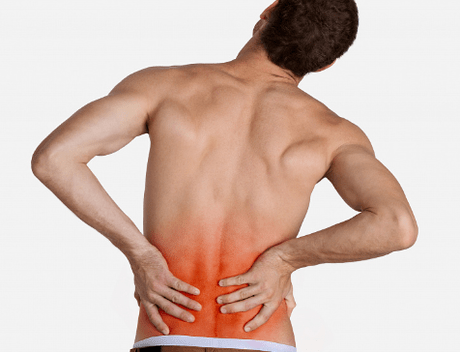Lumbar osteochondrosis is a deformity of the spine in the lumbar region.The disease affects the intervertebral discs, cartilage tissues, spinal roots and nerve fibers and causes back pain.
Reasons

The main cause of the disease is the improper distribution of the load of the musculoskeletal system.Usually this happens when you walk high heels, carry a bag on one side, with an uncomfortable posture in sleep or sitting.Elderly, pregnant, only born, professional athletes and office workers are at risk.
Other causes of lumbar osteochondrosis:
- injuries, bruises, fractures of the hands, legs, spine;
- damage to the organs of the musculoskeletal system;
- gastrointestinal diseases that cause a deficiency of nutrients;
- body tension in prolonged loads;
- Psychomation disorders;
- disorders of the blood flow in the spine;
- inflammation of the musculoskeletal system;
- Internal organs and vertebrae infections;
- Joint stiffness, displacement of the discs;
- convexity and intervertebral hernias;
- heavy intoxication;
- metabolic disorders;
- stand curvature;
- A sedentary lifestyle;
- dehydration;
- an unbalanced diet;
- Calcium and oxygen deficiency;
- Excess weight;
- bad habits;
- Age -related changes;
- Joint diseases.
Symptoms of lumbar osteochondrosis
The intensity and nature of the symptoms depends on the stage of the disease.The more the patient finds signs of lumbosacral osteochondrosis, the more effective the treatment will be.
General symptoms:
- severe pain in the lower back that can give the legs, internal organs of the abdomen and pelvis;
- kidney pain and sacrum;
- fatigue and stress in the lower back and sacral spine;
- Difficulties in moving, walking, inclinations and turns of the body;
- Periodic background at the rear;
- fatigue after a slight workload;
- Back crunching, mobility disorder, calm pain;
- limb numbness;
- spasms and cramps in the muscles;
- dizziness;
- Weakness and loss of strength;
- Reducing muscle tone and sensitivity.
In men and women, the manifestations of lumbar osteochondrosis can vary.Men may have potency problems.Women often suffer from pelvic pain.When the deformed spine cannot fully support the back, the uterus and the appendages experience additional loads and sometimes move around a normal physiological position.
Varieties
The classification of osteochondrosis of the lumbar spine consists of several varieties of the disease.By the type of pain syndrome, they distinguish:
LumbagoSAcute symptom.It is expressed by sharp bastards and inability to move.It happens with muscle cramps, injuries, pinches of discs and nerve roots.
LumbalgiaSIt is characterized by long-term pain in the pain caused by hernia, protrusions, spondylartros, ligaments and other disorders of the musculoskeletal system.
SciaticaSPowerful Lumbosacral Pain Syndrome, Eradir in the pool.The pain is applied to the sciatic nerve, prevents normal bending and lengthening of the body, does not allow me to sit and stand painless.
Discogenic lumbar osteochondrosis and radiculopathy also differ.
Discogenic lumbar osteochondrosisIt is accompanied by a loss of sensitivity and numbness not only of the inflamed back, but also the legs, butt, hips and bottom of the abdomen.Sometimes body temperature rises, weakness, urinary incontinence, the patient loses weight.
RadiculopathyExpressed by numbness of nerve roots and reducing human motor abilities.Signs - numbness or tenderness of the entire lower body, impaired reflexes, reduction of muscle tone and joints of the limbs.
Stages of development of lumbar osteochondrosis
Doctors track the dynamics of the pathology in four stages:
- FirstSThe symptoms are almost invisible - they are diagnosed in X -ray.The stage begins with pathological processes in the targeted cavity of the reinforced disc and micro -cracks of the fibrous ring.
- SecondSThe height of the intervertebral discs is reduced, which makes the vertebrae tightly positioned.This causes sliding and displacement of the vertebrae, which are accompanied by pain during movements.
- ThirdSIt is characterized by stiffness, instability, numbness of the body in the coccyx, lower back and sacrum.This can be explained by the protruding vertebrae, progress, joint dislocations and arthrosis in the spine.
- FourthSThe most gradual degree.The functions of the spine are impaired on it and bone growth (osteophytes) are formed.Plants can pinch the nerves or damage the integrity of the vertebrae.
The effects of lumbar osteochondrosis
- Excessive accumulation of salt in the body;
- development of hernia, convexity, prolapse of vertebrae and discs;
- chronic radiculitis;
- Paresis and paralysis of the legs.
Diagnostics
Lumbar osteochondrosis and other disorders of the musculoskeletal system can diagnose orthopedist, osteopath, neurologist, rheumatologist, manual therapist and surgeon.It is possible to make an accurate diagnosis after:
- X -ray spine, which shows the condition of the bones, cartilage and muscle tissues, as well as the ligaments and tendons.
- Myelography - studies of cerebrospinal fluid with dyes.With their help, nerve roots of the spinal cord are examined and evaluated.
For a more examination, doctors use CT and MRI.You can diagnose the clinic.

























